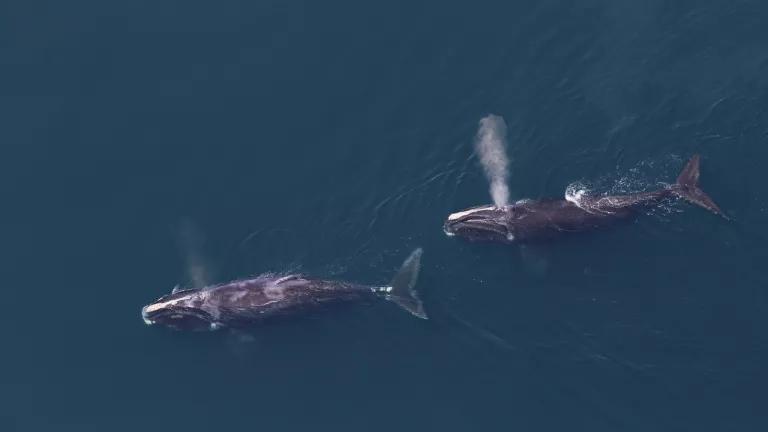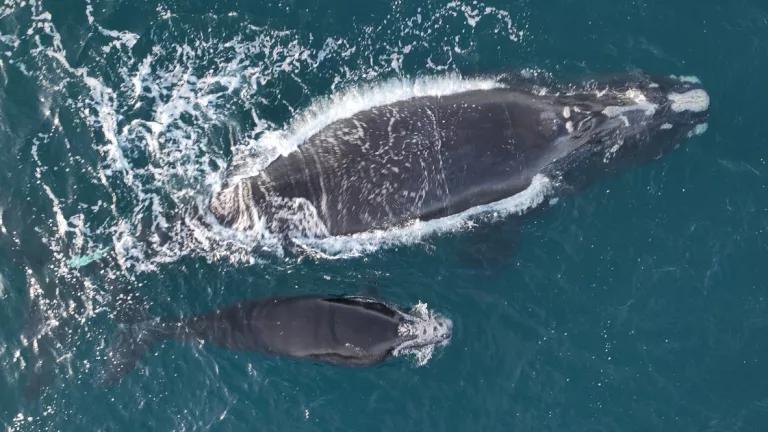
The calf of right whale ‘Tripelago’ rolls into the side of its mother. The pair was sighted east of St. Simons Sound, GA on January 19, 2022.
It’s start of the calving season for the critically endangered North Atlantic right whale. But what should be a time for celebration is marred with worry, as mothers and their newborns are at risk of being hit or even killed by fast moving vessels. NOAA Fisheries should act immediately to protect them.
November 15th is an exciting day for coastal residents in the Southeast. It’s the time of year that expecting right whale mothers arrive at the southernmost point of their arduous and risky migration to give birth in the warm coastal waters off Georgia and Florida. The race to spot the first calf of the season captures the heart of the public each year.
The calving season is an especially important event for this rapidly declining species where only about 340 surviving individuals remain—including only 72 reproductive females. Every calf and every mom is precious.

Right whale mother-calf pairs can be sighted very close to shore off Florida during winter. This pair, right whale Catalog #3430 and calf, was seen just off Jacksonville Beach, FL on December 24, 2021.
But as moms and their newborn calves get to know each other in shallow waters close to shore, they are particularly vulnerable to being killed or injured by vessels. And there have been several tragic events in recent years.
- On January 8, 2020, a newborn calf was seriously injured by a passing vessel off the coast of Georgia. There were heroic efforts to administer treatment to the calf but its prognosis was determined to be poor, and the calf hasn’t been seen since.
- A young calf was then found dead on June 25, 2020, off the coast of New Jersey. Horrifyingly, the calf had been struck twice in its short life; a non-fatal strike occurred several weeks before the collision that killed him. The calf’s mother, known as “Snow Cone,” has since been mortally injured by entanglement in fishing gear.
- A one-month old calf was found stranded in Florida on February 13, 2021, with fatal injuries. The calf’s mother “Infinity” was also hit and injured at the same time.

Mothers and calves are particularly vulnerable to being hit by vessels. This weeks-old calf was struck and killed by a 54-ft sport fishing vessel in February 2021. Its mother, Infinity, was seriously injured at the same time.
Thankfully, there is a simple way we can protect moms and calves from vessel strikes: slowing vessels down to speeds of 10 knots or less. This protective measure can reduce the risk of serious injury and death from a vessel strike by up to 90 percent.
NOAA’s proposed amendments to the North Atlantic right whale Vessel Speed Rule would require vessels 35 feet or longer to slow down within Southeast calving habitat between November 15th through April 15th, the calving season. But these measures aren’t in place yet.
There was widespread support from the conservation community for these proposed measures—more than 15,000 of NRDC’s members and online activists alone spoke up to support the measures.

Zones where vessels 35-feet and longer would be required to travel at speeds of 10-knots or less, based on NOAA Fisheries’ proposed amendments to the North Atlantic right whale Vessel Speed Rule. The Southeast calving habitat is shown in orange.
However, NOAA Fisheries is still deliberating the final amendments, and is expected to publish them next year. But that won’t address this year’s calving season. While we wait, moms and calves are at risk from outdated and insufficient protections.
The agency has a strong plan and should take action right away while it is finalizing the amendments. NRDC and other organizations have called on NOAA Fisheries to implement emergency regulations to protect moms and calves in the Southeast, based on the agency’s proposed amendments.
We urge NOAA Fisheries to implement emergency regulations now, at the start of the calving season, to immediately protect calves and their mothers—the lifeblood at the species—during this time of highest risk.




